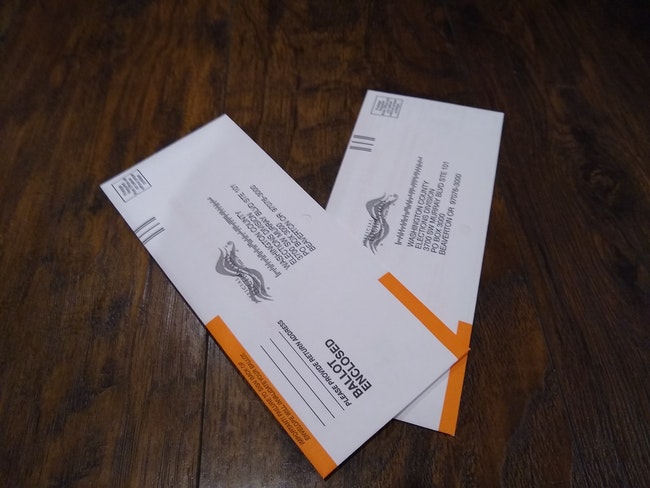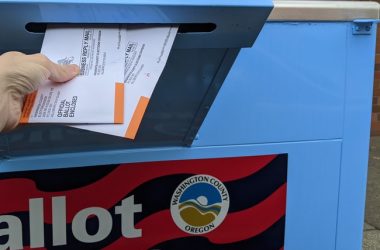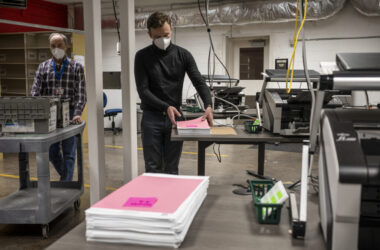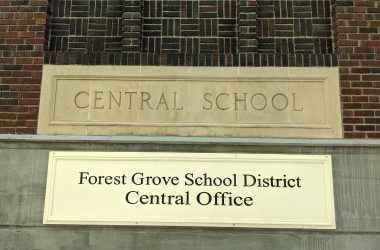 Two ballots from a previous election. File photo: Chas Hundley
Two ballots from a previous election. File photo: Chas Hundley
Voting by mail exclusively became the standard mechanism for casting ballots in Oregon in 1998 by a citizen’s initiative, Measure 60, which voters overwhelmingly approved by a 70 percent margin.
A little more than 1 million eligible voters voted on Measure 60.
The history of Oregon’s vote-by-mail system, however, goes back in time much further than 1998, according to a document on the Oregon Secretary of State’s website detailing the program’s history.
In 1981, Oregon approved a vote-by-mail (VBM) test for local elections. The program was deemed a success and in 1987 the state legislative assembly made it permanent for use in local and special elections.
In May 1988, 41 percent of registered voters in Oregon were permanent absentee voters. Although the primary election that year saw just 35 percent voter turnout – a record low for the state – absentee ballots accounted for two-thirds of all votes cast. That made Oregon the first state to have more ballots cast by mail than in person at polling stations.
It wasn’t until June of 1993 that the first statewide special election was held using the VBM system. Even with voters no longer required to physically go to the polls, voter turnout was muted at 39 percent. A May 1995 special election saw an increase in voters returning their mail-in ballots, but only a 5 percent climb to 44 percent of voters who received a ballot in their mailbox.
Also, in that spring of 1995, both chambers of the Oregon Legislative Assembly approved a proposal to expand VBM to primary and general elections, but it was vetoed by a then newly-elected governor, Democrat John Kitzhaber, who was just in the second month of his first term in Salem.
Later, in December 1995, Oregon became the first state to conduct primary elections solely using mail-in voting to nominate candidates to fill former Republican Sen. Bob Packwood’s federal seat. (Many readers may recall that Packwood resigned from office after threat of expulsion by the Senate Ethics Committee, which investigated him for three years beginning in 1992 following allegations of sexual harassment, abuse, and assault of women.)
In January 1996, Oregon became the first state to conduct a general election using nothing but the VBM system, and voters elected current Democratic Sen. Ron Wyden with a 66 percent VBM turnout.
A 20-year history of Oregon’s general election ballot count
Oregon’s ballot count history dating back to 2000 can be found here on a webpage within the Oregon Secretary of State’s Elections Division website.
It details an interesting relationship between the state’s VBM system and eligible voters, whose ballots literally arrive on their doorstep. Voters require no effort to vote other than filling out the ballot, signing the envelope, and putting it back in their mailbox for pickup by the U.S. Postal Service.
Presidential election years, accordingly, always provide the highest voter turnout in Oregon. For instance, in 2000, the year President George W. Bush defeated then-Vice President Al Gore by a Supreme Court ruling, 80 percent of Oregonians cast their ballot.
comparison, in Nov. 2002, a general election year where Oregon’s governorship was up for grabs following the completion of Kitzhaber’s second-consecutive term, voter turnout still only reached 68 percent.
The 2004 general election, which pitted President Bush against then-Massachusetts Sen. John Kerry, saw voter turnout reach 85 percent. Two years later, during Oregon’s Nov. 2006 general election, in which Governor Ted Kulongoski was re-elected, 70 percent of eligible voters participated.
The 2008 general election, which saw a scrappy, mostly-unknown senator from Illinois named Barack Obama fight for the presidency against long-time politician and American war hero, Sen. John McCain, 84 percent of Oregon voters turned in their ballot.
During the 2010 general election, again a year where Oregon voters would choose a different governor – “different” is used here rather than “new” because Kitzhaber was elected again for what would technically be his third term following eight years, or two terms, of Kulongoski as governor – voter turnout topped out at 70 percent, which incidentally was the same exact turnout percentage when Oregonians voted in Kulongoski for a second term in 2006.
The 2012 general election, which saw former Massachusetts governor Mitt Romney try to defeat President Obama, saw a slight decline in the percentage of voters casting their ballots, down to 81 percent from 85 percent in the 2008 presidential election.
Two years later, in the 2014 general election, Oregonians re-elected Kitzhaber to a second term (in actuality, his fourth term, though Kitzhaber resigned just less than one month after being sworn in as governor during ongoing ethics and criminal investigations into him and his partner Cylvia Hayes – incidentally, the only investigation into a governor by the state attorney general’s office in Oregon history). Just a little less than 71 percent of voters cast ballots in that year’s general election.
The 2016 general election, known more commonly as Trump vs. Hillary, saw 80.3 percent of eligible voters cast their ballot. Early voters cast 1,575,214 ballots from Oct. 23 to Nov. 7, while by contrast, the state received just 476,238 votes on Election Day, Nov. 8.
On a side note, early voting in Oregon is done via U.S. mail and dropbox locations open from 18 to 20 days prior to Election Day, which this year falls on Tuesday, Nov. 3.
During the last presidential election in 2016, Election Day fell on Nov. 8 because federal law says the date is set as the first Tuesday following the first Monday in November. In 2016, Nov. 1 fell on a Tuesday, pushing the election back a week later than when it normally takes place.
The Nov. 2018 general election – where observers predicted Washington D.C. to be hit by a so-called “blue wave,” meaning Democrats would vote in overwhelming numbers and take back the House of Representatives – just 67.8 percent of Oregon voters cast their ballot.
Also of note in that 2018 election, Oregon voters cast 1,376,901 early ballots from Oct. 22 to Nov. 5. while on Election Day, Nov. 6, the Oregon Elections Division received 496,990 ballots.
As for 2008, the year President Obama first ran for office, Oregonians eligible to vote cast 1,449,566 early ballots from Oct. 19 through Nov. 3 with just 385,701 ballots tallied by the state on Election Day, Nov. 4.
For more information about voting in Oregon, it’s history, as well as a history of Oregon’s political parties, visit the secretary of state’s elections division website.






